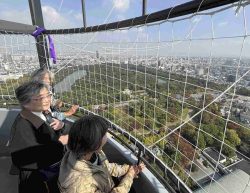
The Kumano Kodo pilgrimage routes stretch through a forest in Tanabe, Wakayama Prefecture.
6:00 JST, September 24, 2023
WAKAYAMA — The Kumano Kodo pilgrimage routes with a thousand-year history are seeing a post-pandemic revival, just as the 20th anniversary of their listing as a UNESCO World Heritage site approaches next year.
The number of foreign tourists taking to the Kumano Kodo trails plummeted during the pandemic, but has been on the upswing since border control measures were eased last year.
Since ancient times, the mountains in the Kii Peninsula, which encompasses most of present-day Wakayama Prefecture and part of Mie Prefecture, have been believed to be the home of Shinto and Buddhist deities — thus the abundance of shrines and temples.
The Kumano Kodo trails have long attracted people seeking spiritual renewal on the sacred paths, and are particularly popular with foreign tourists.

Nachi Waterfall in January
The “Sacred Sites and Pilgrimage Routes in the Kii Mountain Range,” which includes Kumano Kodo, was registered as a World Cultural Heritage site in 2004. There are three sacred sites — Yoshino and Omine, Kumano Sanzan and Koyasan — which are linked by the pilgrimage routes.
Kumano Sanzan comprises the three shrines of Kumano Hongu Taisha, Kumano Hayatama Taisha and Kumano Nachi Taisha, as well as the Seigantoji and Fudarakusanji temples, and the Nachi Waterfall. All have long been places of worship.
Kongobuji temple in Koyasan is the base of the Koyasan Shingon sect of Buddhism, which was founded by the Buddhist monk Kukai (774-835), also known as Kobo Daishi. Yoshino and Omine comprise a sacred site for mountain asceticism incorporating a treacherous mountain trail.

Tokei Shrine in Tanabe in October last year
In 2016, 22 more sites were added to the World Heritage listing, including Tokei Shrine known for being an associated shrine of Kumano Sanzan. This increased the total World Heritage registered area to 506 hectares.
What really stands out, though, are the pilgrimage routes that stretch for a combined total of 348 kilometers. The most famous are the Nakahechi, Ohechi and Kohechi routes, collectively known as the Kumano Kodo.

The Nakahechi route connects Tanabe, Wakayama Prefecture, with the Kumano Hongu Taisha, Kumano Hayatama Taisha and Kumano Nachi Taisha shrines. The Ohechi route runs along the Kii Peninsula coast, while the Kohechi route links Koyasan and Kumano Sanzan.
With their dense forests and clear streams, the Kii mountains have long been considered sacred places where gods reside and bliss is bestowed on mortal men.
Legend has it that a visit by retired emperor Uda to the Kii mountains in 907 kindled subsequent mass pilgrimages to the sacred sites.

A small jizo stone statue is seen along the Nakahechi route. Jizo statues are said to have been built as memorials for pilgrims who died along the route.

The Hyakkengura look-out point along the Kumano Kodo Nakahechi route.
Kumano was not immune from the anti-Buddhist movement that swept the country in the late 19th century, and the pilgrimages vastly decreased.
But with the UNESCO listing, the paths for purifying body and soul were revived. Routes once traversed by ancient aristocrats are now popular with people from around the world.
According to Wakayama prefectural government, the only other example of pilgrimage routes being designated as a World Heritage site is the “Routes of Santiago de Compostela” which encompasses Spain and France. As such, in 1998 the prefecture concluded a “sister route” agreement with the state of Galicia, Spain. It is said that quite a few people have traveled both pilgrimage routes.

A small jizo stone statue is seen along the Nakahechi route. Jizo statues are said to have been built as memorials for pilgrims who died along the route.
Fostering English-speaking guides
In preparation for an expected influx of foreign visitors, the Tanabe City Kumano Tourism Bureau, which organizes walking tours along the Kumano Kodo and other activities, started a program to train English-speaking guides.

Canadian Brad Towle, left, gives a lesson on communicating in English with tourists in front of a carved wooden statue of a mountain priest in Tanabe in January.
The organization was established in 2006 following the registration of the area as a World Cultural Heritage site. The bureau launched a website in six languages, and has handled all arrangements for foreign tourists.
Thanks to the success of promotional efforts aimed at overseas visitors, the number using the bureau’s services increased from about 2,000 in 2011 to about 15,000 in 2019. However, this led to a problem of having an insufficient number of English-speaking guides.
Canadian Brad Towle is among the staff members who have been providing guidance on communicating in English with tourists in an easy-to-understand and entertaining way.
In 2020, at the start of the pandemic, almost no foreigners visited the Kumano Kodo routes. That led to a difficult period, but with the reopening of tourism, the bureau is back on its feet, training human resources for the post-pandemic period. Its efforts include a series of lectures given two days a month.
“Tourists develop lasting memories by interacting with guides who are rooted in the local community,” an official of the organization said. “We hope to increase the attraction of the Kumano Kodo routes for foreign tourists.”
Related Tags
"Features" POPULAR ARTICLE
-

Sanrio to Open Museum in Yamanashi Pref. Dedicated to Founder, Exhibits Include Hello Kitty, Other Characters
-

Autumn Foliage Surrounds Visitors to Tokyo’s Showa Kinen Park
-

My Daughter No Longer Speaks to Me, But I Want to See Her and My Grandchild
-

Kumamoto: Public Bath Refurbished as Library Where You Can Chat, Take Photos
-

Frozen Vegetables: Demand Rises for Convenient, Tasty Domestic Produce
JN ACCESS RANKING
-

Keidanren Chairman Yoshinobu Tsutsui Visits Kashiwazaki-Kariwa Nuclear Power Plant; Inspects New Emergency Safety System
-

Imports of Rare Earths from China Facing Delays, May Be Caused by Deterioration of Japan-China Relations
-

University of Tokyo Professor Discusses Japanese Economic Security in Interview Ahead of Forum
-

Japan Pulls out of Vietnam Nuclear Project, Complicating Hanoi’s Power Plans
-

Govt Aims to Expand NISA Program Lineup, Abolish Age Restriction





















